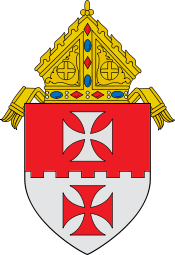James Keane (bishop)
| Most Reverend James John Keane, DD | |
|---|---|
| Archbishop of Dubuque | |
 | |
| Church | Roman Catholic Church |
| See | Dubuque |
| In office | August 11, 1911 – August 2, 1929 |
| Predecessor | John Joseph Keane |
| Successor | Francis J. L. Beckman |
| Orders | |
| Ordination | December 23, 1882 |
| Consecration |
October 28, 1902 by John Ireland |
| Personal details | |
| Born |
August 26, 1857 Joliet, Illinois |
| Died |
August 2, 1929 (aged 71) Dubuque, Iowa |
| Previous post | Bishop of Cheyenne |
| Ordination history of James Keane (bishop) | |
|---|---|
Episcopal consecration | |
| Principal consecrator | John Ireland |
| Date of consecration | October 12, 1902 |
Bishops consecrated by James Keane (bishop) as principal consecrator | |
| Patrick Aloysius Alphonsus McGovern | April 11, 1912 |
| James Albert Duffy | April 16, 1913 |
| Edmond Heelan | April 8, 1919 |
| Thomas William Drumm | May 21, 1919 |
| Henry Rohlman | May 20, 1927 |
James John Keane (August 26, 1857 – August 2, 1929) was a 20th-century archbishop of the Catholic Church in the United States. He served as bishop of the Diocese Cheyenne in the state of Wyoming from 1902–11, and as archbishop of the Archdiocese of Dubuque from 1911–1929.
Early Life & Ministry
James Keane was born August 26, 1857 in Joliet, Illinois, and raised in Minnesota. He was educated at St. John's Seminary in Collegeville, Minnesota, St. Francis Xavier College in New York City and the Grand séminaire de Montréal. Keane was ordained a priest on December 23, 1882 for the Archdiocese of Saint Paul. He was initially involved in parish work after ordination and then served as a professor and rector (1888) at the College of St. Thomas in St. Paul, Minnesota. He was named a pastor after he finished serving as rector at St. Thomas.[1]
Bishop of Cheyenne
On June 10, 1902 Pope Leo XIII appointed Keane as the third bishop of Diocese of Cheyenne. He was consecrated on October 28, 1902 by Archbishop John Ireland of Saint Paul. Bishops Joseph Bernard Cotter of Winona and James McGolrick of Duluth were the principal co-consecrators.[2] Keane came to Wyoming at a time of increased population and economic expansion. Bishop Keane needed to recruit priests who would be willing to work in the difficult environment of Wyoming, and was successful in doing so.[3] The diocese was incorporated according to the laws of the state of Wyoming. The parishes of the diocese were likewise incorporated with the bishop, the pastor and two lay trustees serving as a corporate board at each parish. He was successful in his appeals to the newly formed Catholic Church Extension Society for funds to expand the church across the state. He also directed the building of Cheyenne's St. Mary's Cathedral and a new episcopal residence. The cathedral was dedicated in 1909. He served the diocese as its bishop for nine years.[4]
Archbishop of Dubuque
Following the retirement of Archbishop John Keane, Pope St. Pius X named Bishop Keane the fifth bishop and third archbishop of Dubuque on August 11, 1911. Even though he succeeded a man who shared his last name, they were not related, the two men had very different personalities. John Keane was well liked in the community, and nicknamed "Sugar" for his kind and generous nature. James Keane however, would come to be nicknamed "Hickory" due to his stern nature.
On the same day that Keane was named Archbishop of Dubuque, the Diocese of Des Moines was established from the western half of the Diocese of Davenport. To compensate it for the loss of territory, Clinton County was given to the Davenport Diocese from the archdiocese. At this time the present boundaries of the archdiocese were established.
One of Keane's interests as archbishop was Columbia (now Loras) College. When he came to Dubuque, Columbia had an enrollment of 330 and a staff of 20. By the time he died it had an enrollment of 700 and a faculty of 48. He began an endowment fund for the college in 1917, and it became one of only seven Catholic educational institutions in the U.S. with an endowment fund of at least one million dollars .[5] He also started the diocesan newspaper, the Witness.
Two movements were of interest to Keane during his time as archbishop. He was known as a staunch supporter of the temperance movement, and Keane took every opportunity to speak out against alcohol consumption. He was also a member of the Irish Peace Commission of 1920, which was focused on the conflict between England and Ireland. He gained national notoriety as one of the speakers at the 1926 World's Alliance for International Friendship.[5]
Keane led the archdiocese for 18 years until his death on August 2, 1929. Like his predecessor, James Keane was buried at Mount Olivet Cemetery in Key West, Iowa.
| Catholic Church titles | ||
|---|---|---|
| Preceded by Thomas Mathias Lenihan |
 Bishop of Cheyenne 1902–1911 |
Succeeded by Patrick Aloysius Alphonsus McGovern |
Notes
- ↑ Delaney, John J, Tobin, James Edward (1961). Dictionary of Catholic Biography. Garden City, New York: Doubleday.
- ↑ "Archbishop James John Keane". Catholic-Hierarchy.org. David M. Cheney. Retrieved 21 January 2015.
- ↑ http://www.dioceseofcheyenne.org/history/1887__Pioneers_Stansell.html
- ↑ http://www.dioceseofcheyenne.org/bkeane.html
- 1 2 http://www.encyclopediadubuque.org/index.php?title=KEANE%2C_James_J.

